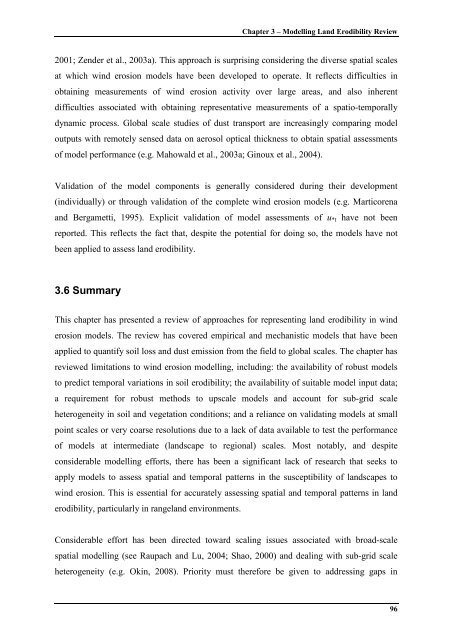Wind Erosion in Western Queensland Australia
Modelling Land Susceptibility to Wind Erosion in Western ... - Ninti One
Modelling Land Susceptibility to Wind Erosion in Western ... - Ninti One
You also want an ePaper? Increase the reach of your titles
YUMPU automatically turns print PDFs into web optimized ePapers that Google loves.
Chapter 3 – Modell<strong>in</strong>g Land Erodibility Review2001; Zender et al., 2003a). This approach is surpris<strong>in</strong>g consider<strong>in</strong>g the diverse spatial scalesat which w<strong>in</strong>d erosion models have been developed to operate. It reflects difficulties <strong>in</strong>obta<strong>in</strong><strong>in</strong>g measurements of w<strong>in</strong>d erosion activity over large areas, and also <strong>in</strong>herentdifficulties associated with obta<strong>in</strong><strong>in</strong>g representative measurements of a spatio-temporallydynamic process. Global scale studies of dust transport are <strong>in</strong>creas<strong>in</strong>gly compar<strong>in</strong>g modeloutputs with remotely sensed data on aerosol optical thickness to obta<strong>in</strong> spatial assessmentsof model performance (e.g. Mahowald et al., 2003a; G<strong>in</strong>oux et al., 2004).Validation of the model components is generally considered dur<strong>in</strong>g their development(<strong>in</strong>dividually) or through validation of the complete w<strong>in</strong>d erosion models (e.g. Marticorenaand Bergametti, 1995). Explicit validation of model assessments of u *t have not beenreported. This reflects the fact that, despite the potential for do<strong>in</strong>g so, the models have notbeen applied to assess land erodibility.3.6 SummaryThis chapter has presented a review of approaches for represent<strong>in</strong>g land erodibility <strong>in</strong> w<strong>in</strong>derosion models. The review has covered empirical and mechanistic models that have beenapplied to quantify soil loss and dust emission from the field to global scales. The chapter hasreviewed limitations to w<strong>in</strong>d erosion modell<strong>in</strong>g, <strong>in</strong>clud<strong>in</strong>g: the availability of robust modelsto predict temporal variations <strong>in</strong> soil erodibility; the availability of suitable model <strong>in</strong>put data;a requirement for robust methods to upscale models and account for sub-grid scaleheterogeneity <strong>in</strong> soil and vegetation conditions; and a reliance on validat<strong>in</strong>g models at smallpo<strong>in</strong>t scales or very coarse resolutions due to a lack of data available to test the performanceof models at <strong>in</strong>termediate (landscape to regional) scales. Most notably, and despiteconsiderable modell<strong>in</strong>g efforts, there has been a significant lack of research that seeks toapply models to assess spatial and temporal patterns <strong>in</strong> the susceptibility of landscapes tow<strong>in</strong>d erosion. This is essential for accurately assess<strong>in</strong>g spatial and temporal patterns <strong>in</strong> landerodibility, particularly <strong>in</strong> rangeland environments.Considerable effort has been directed toward scal<strong>in</strong>g issues associated with broad-scalespatial modell<strong>in</strong>g (see Raupach and Lu, 2004; Shao, 2000) and deal<strong>in</strong>g with sub-grid scaleheterogeneity (e.g. Ok<strong>in</strong>, 2008). Priority must therefore be given to address<strong>in</strong>g gaps <strong>in</strong>96
















